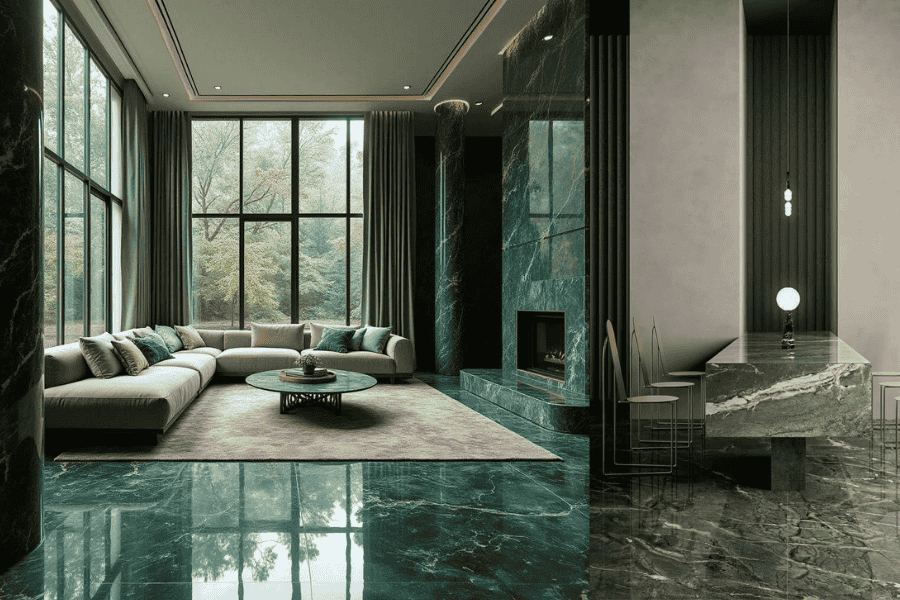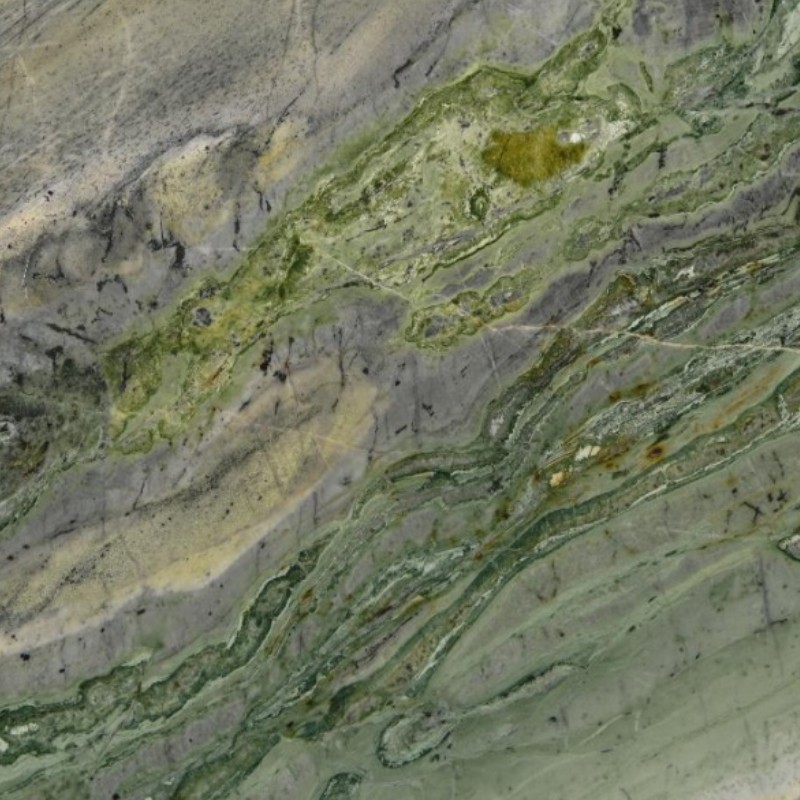Where Minimalism Meets Material Reality
“Are we sure this green marble feature wall won’t make the lobby feel busy?”
The architect stared at the rendering: bare concrete, slim black frames, a quiet grey floor—and one bold slice of stone at reception. The developer loved the luxury signal; the project manager worried about maintenance; the structural engineer was already thinking about load paths, moisture, and slip ratings.
That’s the reality of modern minimalist projects built on concrete and precast systems. A single green marble surface can make or break the entire composition. Used well, it becomes a calm focal point that adds depth and value. Used badly, it turns into a visual and technical liability: too loud, too soft, or too fragile for the space.
This guest post explores how builders, designers, and commercial contractors can use green marble in minimalist interiors without sacrificing performance—drawing on engineering criteria, ESTA research highlights, and export experience from ICE STONE’s global projects.

Green Marble
Why Green Marble Works So Well With Minimalist Concrete Design
Minimalist interiors rely on a short material list: concrete, plaster, glass, metal, maybe one or two natural finishes. In this framework, green marble earns its place because it does three things at once:
-
Adds natural movement to otherwise flat planes
-
Introduces colour in a controlled, sophisticated way
-
Signals quality and permanence to tenants and visitors
Psychology and colour research consistently show that green-based palettes are associated with calmness, balance, and biophilic comfort—exactly what many corporate, hospitality, and residential lobbies are trying to achieve. The trick is to keep the rest of the envelope quiet so the stone reads as a single, intentional gesture, not a pattern explosion.
A good starting point is a refined, cool-toned material like Ice Connect Marble, where a light background carries subtle jade-like movement. In a minimalist interior, this type of stone works beautifully as a reception desk cladding or a single wall panel behind a concrete stair, allowing light to play across its surface without overwhelming the space.
Start From Performance: Not Every Green Marble Belongs on the Floor
From a concrete contractor’s point of view, every green marble surface sits on top of structure, screeds, and adhesives. That means the stone needs to match its use zone:
-
High-traffic floors demand low absorption, strong flexural strength, and good abrasion resistance.
-
Walls and columns can tolerate more fragile compositions, as they carry less mechanical stress.
-
Worktops and bar counters must handle staining risk and cleaning chemicals.
Several EST-aligned studies on stone flooring have shown that slabs with lower water absorption and higher density experience significantly fewer failures over a 10-year period—especially in cold climates with de-icing salts and heavy cleaning regimes.
For feature floors in minimalist lobbies, dark, structured stones like Lush Volcanic Green Marble offer a compelling balance: dramatic patterning, but with a robust base and engineered slab thickness that stand up to real traffic. Paired with clean concrete walls and slim metal details, they create a grounded, monolithic feel rather than ornamental clutter.
From Quarry to Block: Controlling Tone in Green Marble
Visual calm is a non-negotiable in minimalist design. That means designers cannot rely on random slab availability; they need consistent tone, grain, and veining across the entire project.
Here, quarry discipline and block selection are crucial. Good exporters select blocks not just for beauty but for:
-
Continuity of colour across the block
-
Predictable veining direction
-
Minimal structural defects and open fissures
-
Known performance in previous projects
Long-running materials like China Antique Green Marble Ancient Times Raggio Verde block have built their reputation precisely because they deliver repeatable tone and cutting performance. When blocks are chosen at this level, you can plan long continuous wall runs, book-matched panels, and spare stock for future repairs—all from the same visual family.
This block-level control is what keeps a minimalist interior from turning into a patchwork of slightly different greens under real lighting conditions.
Green marble isn’t just “a coloured stone”—it’s a serpentine-rich metamorphic material whose mineralogy directly affects performance in minimalist interiors. Its signature tones come from serpentine, chlorite, and trace minerals such as chromium and nickel, giving the stone its dense, compact structure and the ability to take a high polish. This crystalline density is what allows green marble to reflect light softly, making it particularly effective in clean, low-material spaces.From an engineering perspective, most green marble sits around 3–4 on the Mohs hardness scale. While not as hard as granite, it provides enough compressive strength for wall cladding, low-traffic floors, feature slabs, and vertical installations. Designs that require quiet surfaces—such as spa-like lobbies, modern stair cores, or restrained reception rooms—benefit from its cloud-like veining and organic movement.However, its material behaviour must be respected. Because green marble is susceptible to acid etching and moisture staining, minimalist use requires sealing, controlled lighting, and thoughtful placement away from aggressive cleaning cycles. When properly maintained, the stone delivers long-term durability with a timeless aesthetic maturity ideal for both residential and commercial interiors.
Green marble isn’t just “a coloured stone”—it’s a serpentine-rich metamorphic material whose mineralogy directly affects performance in minimalist interiors. Its signature tones come from serpentine, chlorite, and trace minerals such as chromium and nickel, giving the stone its dense, compact structure and the ability to take a high polish. This crystalline density is what allows green marble to reflect light softly, making it particularly effective in clean, low-material spaces.
From an engineering perspective, most green marble sits around 3–4 on the Mohs hardness scale. While not as hard as granite, it provides enough compressive strength for wall cladding, low-traffic floors, feature slabs, and vertical installations. Designs that require quiet surfaces—such as spa-like lobbies, modern stair cores, or restrained reception rooms—benefit from its cloud-like veining and organic movement.
However, its material behaviour must be respected. Because green marble is susceptible to acid etching and moisture staining, minimalist use requires sealing, controlled lighting, and thoughtful placement away from aggressive cleaning cycles. When properly maintained, the stone delivers long-term durability with a timeless aesthetic maturity ideal for both residential and commercial interiors.
Slabs, Layouts, and Minimalist Geometry
Once blocks are selected, slab cutting and layout planning decide whether green marble reads as calm geometry or noisy pattern. In a minimalist space, a few strategies almost always work better:
-
Use large, clean pieces instead of many small cuts.
-
Align veining direction with the main axis of the room.
-
Avoid overly complex book-matching where everything else is simple.
-
Reserve the boldest slabs for one or two hero surfaces.
Stones processed specifically for flooring and large wall planes—such as Green Ancient Times Raggio Verde flooring slabs—are calibrated to consistent thickness and backed with the right reinforcement mesh. That makes it easier for installers to maintain tight joints, flat planes, and precise transitions to concrete or engineered substrates.
For contractors, this means fewer surprises on site; for designers, it means the stone reads like one big plane instead of a grid of competing tiles.

Green Marble Flooring
Colour Strategy: White, Concrete Grey, and Green Marble
Minimalist projects often sit on a palette triangle: white, grey, and one accent. Green marble can be that accent—but the safest results come from using it within a controlled family of tones.
One proven approach is to combine concrete, light walls, and white marble with green veins. These stones knit together the brightness of white with the depth of green, acting as a bridge between cool grey concrete and warmer interior lighting.
In practice, you might see:
-
Concrete or terrazzo floors
-
White or off-white walls
-
A single green marble bench, countertop, or wall panel with green-veined white stone
This balance keeps the space minimalist while still delivering the “wow” moment clients expect from natural stone. It also allows the same material family to be used in multiple zones—lobby, washrooms, elevator halls—without feeling repetitive or chaotic.
Maintenance: Minimalist Does Not Mean Maintenance-Free
One of the hidden traps in minimalist interiors is maintenance. Every mark on a simple surface is visible; every scratch on a dark green marble slab stands out against the clean lines. That’s why a maintenance plan is as important as the material choice.
Key factors include:
-
Using pH-neutral cleaners instead of harsh chemicals
-
Choosing sealers appropriate to the stone’s porosity
-
Planning periodic polishing, especially in high-traffic paths
-
Training cleaning teams to treat marble differently from vinyl or concrete
ICE STONE’s guidance on how to maintain natural marble emphasises that polishing and appropriate cleaning chemistry are “the key” to keeping surfaces consistent over time. ESTA maintenance notes back this up, pointing out that a surprising percentage of stone “failures” are actually cleaning mistakes, not material defects.
In a minimalist interior, smart maintenance is not optional; it is part of the design brief.
Why Work With a Stone Partner Who Thinks Like a Builder
For concrete and precast specialists, the safest way to integrate green marble is to collaborate with a supplier who understands both the aesthetics and the structural context. Surface decisions should be informed by:
-
Substrate type and flatness tolerances
-
Joint layout and movement joints
-
Underfloor heating or thermal gradients
-
Moisture dynamics between concrete and stone
On ICE STONE, you’ll find not only product entries but also case studies that show how green and white marbles have been used in hotels, offices, and public projects around the world. ESTA bulletins have repeatedly praised exporters that share performance data and installation guidance instead of treating stone as a standalone luxury product.
When a project needs help selecting the right green marble variant, confirming slip resistance, or planning for future replacements, the ICE STONE contact team can provide technical support, sampling, and logistics advice. That kind of partnership is what turns a risky “statement material” into a reliable component of a minimalist scheme.

Natural Ming Green Marble
FAQ: Green Marble in Minimalist Interiors
1. Is green marble too strong for minimalist design?
2. Can green marble be used on floors in high-traffic areas?
Yes, provided you choose a dense, low-absorption stone with good abrasion resistance and specify the correct finish (often honed rather than highly polished). Structural slabs like the engineered flooring ranges discussed above are designed for real loading conditions.
3. Does green marble require special maintenance compared to other stones?
Some green marble types can be more sensitive to acids and harsh chemicals, so pH-neutral cleaners and appropriate sealers are important. Regular, planned polishing helps maintain a uniform appearance in minimalist spaces where every mark is visible.
4. How do I avoid visual chaos when using strong-veined green marble?
Use larger pieces, keep joints aligned with the architecture, and avoid mixing too many different stone types. Choosing from a coordinated family—such as white stone with green veining—helps ensure the entire interior feels intentional and restrained.
5. What’s the biggest mistake teams make with green marble in minimalist projects?
Treating it as pure decoration and ignoring performance. When the stone’s mineralogy, absorption, and structural behaviour aren’t matched to the substrate and use case, cracks, stains, or tone shifts appear early—and they’re impossible to hide in a minimalist setting.
Green Marble as the Quiet Anchor of Minimalism
Used carelessly, green marble can overpower a minimalist interior. Used with structural thinking and material discipline, it becomes the quiet anchor that holds the whole composition together.
By starting from performance, choosing stable blocks, planning slab layouts, controlling colour families, and locking in a realistic maintenance plan, you can integrate green marble into concrete-based architecture with confidence. ESTA research and ICE STONE’s case history both point to the same lesson: when stone is treated as part of the building system—not just a last-minute finish—it delivers decades of calm, resilient beauty.
For builders, designers, and contractors working on modern minimalist projects, that’s the real goal: a single, powerful material gesture that looks intentional on day one—and still feels right in year ten.
In the end, the success of green marble in a minimalist interior is less about colour and more about control—controlling tone variation, absorption rate, surface finish, and the structural conditions behind the stone. As ESTA’s recent material-performance update notes, “natural stone is stable only when its physical properties match its architectural environment.” ICE STONE’s export cases repeatedly confirm this principle: when the stone is selected from consistent geological zones, reinforced with proper backing, installed on moisture-managed substrates, and sealed using a breathable coating, its performance aligns closely with long-term architectural expectations.Designers tend to see green marble as a visual accent; engineers see it as a load-bearing finish; contractors see it as a maintenance commitment. The most successful projects are the ones where these three perspectives merge early. By approaching green marble as part of an integrated building system—not merely an aesthetic object—minimalist spaces maintain their clarity, durability, and calm identity for years to come.







